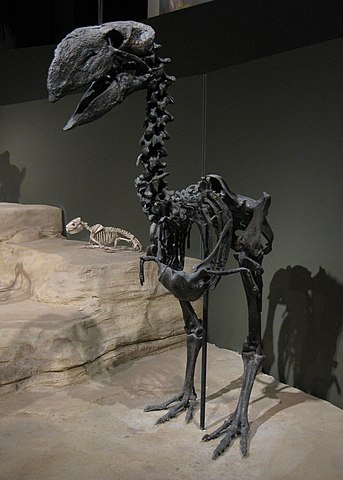Gastornis, often referred to as the “terror bird” (though not related to the later Phorusrhacidae), was a large, flightless bird that lived during the Eocene epoch, approximately 56 to 34 million years ago. Here’s a closer look at this enigmatic apex predator:
1. Taxonomy and Evolution:
- Family: Gastornis belonged to the family Gastornithidae.
- Misconception: Previously, Gastornis was thought to be a fierce predator, earning it the nickname “terror bird.” However, recent studies suggest a herbivorous or omnivorous diet.

2. Size and Physical Characteristics:
- Large Size: Gastornis was a sizable bird, with estimates of its height ranging from 6.6 to 9.8 feet (2 to 3 meters).
- Robust Build: It had a robust build, powerful legs, and a large beak.
3. Beak and Feeding Behavior:
- Large Beak: Gastornis had a large, robust beak, which was initially interpreted as a predatory adaptation.
- Herbivorous Diet: Recent studies based on its beak morphology and isotopic analysis of its fossilized bones suggest a herbivorous or omnivorous diet, likely feeding on plants, seeds, and small animals.
4. Leg Structure:
- Cursorial Adaptations: Gastornis had well-developed, cursorial (adapted for running) legs, indicating its terrestrial lifestyle.
- Swift Runner: Its limb morphology suggests it was a swift runner, capable of chasing down prey or evading predators.
5. Habitat and Distribution:
- Global Distribution: Fossils of Gastornis have been found in various locations around the world, including Europe, North America, and Asia.
- Paleoenvironments: It inhabited a range of paleoenvironments, from forests to open grasslands.
6. Apex Predator Misconception:
- Reevaluation of Diet: While once considered an apex predator, recent studies have led to a reevaluation of Gastornis’ diet, challenging the notion that it was a top carnivorous predator.
- Ecological Role: It likely played a role in the ecosystems it inhabited, but as a herbivore or omnivore rather than a fierce predator.
7. Extinction:
- End of the Eocene: Gastornis went extinct by the end of the Eocene epoch, and its extinction is likely linked to changes in global climate and ecosystems.
8. Scientific Significance:
- Paleontological Discoveries: Gastornis fossils, including bones and footprints, have provided important information about the anatomy and behavior of this ancient bird.
- Evolving Perspectives: Ongoing research and advances in paleontological techniques continue to refine our understanding of Gastornis’ biology and ecological role.
Gastornis, once thought to be a fearsome predator, has undergone a transformation in scientific understanding, highlighting the dynamic nature of paleontological research. Ongoing discoveries and advancements in analytical techniques continue to enhance our knowledge of this intriguing Eocene-era bird.











